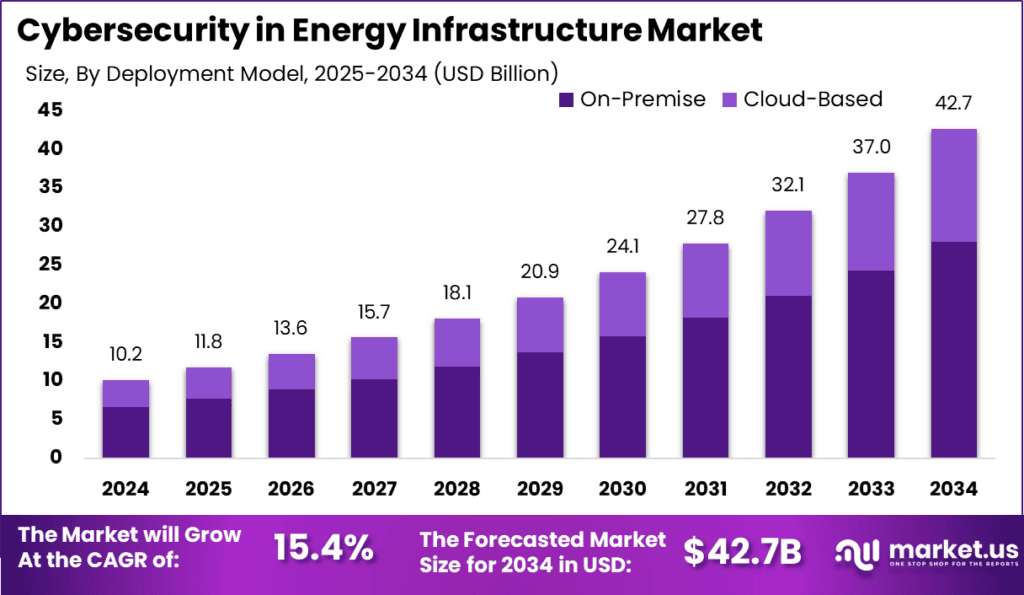Table of Contents
Introduction
The global Cybersecurity in Energy Infrastructure market is projected to reach approximately US$ 42.7 billion by 2034, up from US$ 10.2 billion in 2024, growing at a CAGR of 15.4% between 2025 and 2034. In 2024, North America led the market with a 35.5% share, generating revenue of US$ 3.6 billion. The increasing frequency of cyberattacks on critical energy infrastructure and the growing adoption of digital technologies in the energy sector are key growth drivers. Rising government regulations and investments in security solutions further propel market expansion.

How Growth is Impacting the Economy
The rapid growth of cybersecurity in energy infrastructure significantly impacts the global economy by safeguarding critical assets and ensuring an uninterrupted energy supply. Enhanced security reduces the risk of costly cyberattacks that can disrupt energy production and distribution, protecting economic stability. Investments in cybersecurity technologies create jobs in IT, engineering, and consulting sectors, stimulating economic activity. Furthermore, securing energy infrastructure builds investor confidence and supports the transition to smart grids and renewable energy sources. This growth fosters innovation, promotes safer energy consumption, and helps maintain regulatory compliance, ultimately contributing to sustainable economic development worldwide.
➤ Get valuable market insights here @ https://market.us/report/cybersecurity-in-energy-infrastructure-market/free-sample/
Impact on Global Businesses
Global businesses in the energy sector face rising costs due to increased investment in cybersecurity infrastructure and compliance with stringent regulations. Supply chains become more complex as companies integrate advanced security measures to protect against sophisticated cyber threats. Sector-specific impacts are notable in utilities, oil & gas, and renewable energy, where breaches can lead to operational downtime and safety hazards. Companies must enhance their risk management frameworks and collaborate with cybersecurity experts to mitigate vulnerabilities. The evolving threat landscape pushes businesses to adopt proactive defense mechanisms, influencing operational strategies and technology adoption globally.
Strategies for Businesses
Businesses should implement multi-layered cybersecurity frameworks combining network security, endpoint protection, and threat intelligence. Regular risk assessments and penetration testing help identify vulnerabilities. Investing in employee training enhances awareness and reduces insider threats. Collaborating with government agencies and cybersecurity firms facilitates threat information sharing and rapid response. Leveraging AI and machine learning enables predictive threat detection and automated incident management. Companies must also ensure compliance with industry standards and regulations to avoid penalties and reputational damage.
Key Takeaways
- Cybersecurity in the Energy Infrastructure market to reach US$ 42.7 billion by 2034
- North America leads with 35.5% market share in 2024
- CAGR of 15.4% driven by rising cyber threats and regulations
- Growth supports job creation and economic stability
- Businesses need advanced, proactive security strategies
➤ Buy Full PDF report here @ https://market.us/purchase-report/?report_id=149717
Analyst Viewpoint
Currently, the cybersecurity market for energy infrastructure is experiencing accelerated growth due to increasing digitization and cyber threats targeting critical assets. The future outlook is positive, with AI-driven security solutions and regulatory support enhancing market potential. Adoption of smart grid technologies and renewable energy increases demand for robust cybersecurity. The market is expected to witness continuous innovation and collaboration among stakeholders, ensuring resilient energy systems globally. Companies prioritizing comprehensive security measures will gain a competitive advantage and mitigate risks effectively.
Regional Analysis
North America dominated the cybersecurity in energy infrastructure market in 2024 with a 35.5% share, supported by advanced technological adoption and stringent regulations. Europe follows with steady growth driven by increased investments in smart grids. Asia Pacific is an emerging region with rapid industrialization and rising cyberattack incidents, prompting security upgrades. Latin America and the Middle East & and Africa are witnessing growing awareness and government initiatives to strengthen energy cybersecurity. Regional differences in infrastructure maturity and regulatory frameworks influence tailored market approaches.
➤ Discover More Trending Research
- Engineering Services Outsourcing (ESO) Market
- IT Infrastructure Management Tools Market
- Digital Commerce Market
- Specialty Insurance Market
Business Opportunities
Opportunities include developing AI-based threat detection, cloud security solutions, and blockchain applications for secure energy transactions. Demand for managed security services and incident response in emerging markets is rising. Integration of cybersecurity in renewable energy systems and smart grids presents niche growth areas. Collaborations with governments for critical infrastructure protection open new avenues. Additionally, training and consulting services addressing the shortage of skilled cybersecurity professionals provide business expansion prospects, supporting the overall market ecosystem.
Key Segmentation
The market segments include:
Solution Type
- Network Security
- Endpoint Security
- Identity & Access Management
Deployment Mode
- On-Premises
- Cloud-Based
Energy Sector
- Oil & Gas
- Power Generation
- Transmission & Distribution
These segments address diverse security needs across energy infrastructure.
Key Player Analysis
Leading market players focus on integrating AI, machine learning, and blockchain technologies into cybersecurity offerings. They emphasize innovation, strategic partnerships, and compliance with global energy regulations. Expanding service portfolios to include managed detection and response enhances competitiveness. Strong investments in R&D and workforce training enable rapid adaptation to evolving threats. Geographic expansion and customized solutions for different energy sectors strengthen market positions. Customer-centric approaches and robust incident management capabilities differentiate top players in this rapidly growing market.
Recent Developments
- Launch of AI-driven cybersecurity platforms tailored for energy infrastructure in 2024
- Expansion of cloud-based security services in North America during 2023
- Strategic partnerships between cybersecurity firms and energy utilities in 2024
- Deployment of blockchain solutions for secure energy transactions was introduced in 2023
- Enhanced regulatory frameworks promoting cybersecurity investments in Europe in 2024
Conclusion
The cybersecurity market in energy infrastructure is poised for substantial growth, driven by rising threats and digital transformation. Businesses adopting advanced technologies and proactive strategies will capitalize on expanding opportunities while ensuring energy sector resilience.
Discuss your needs with our analyst
Please share your requirements with more details so our analyst can check if they can solve your problem(s)



